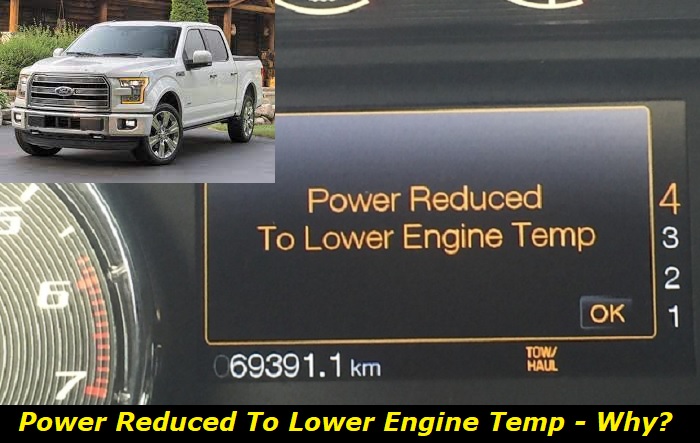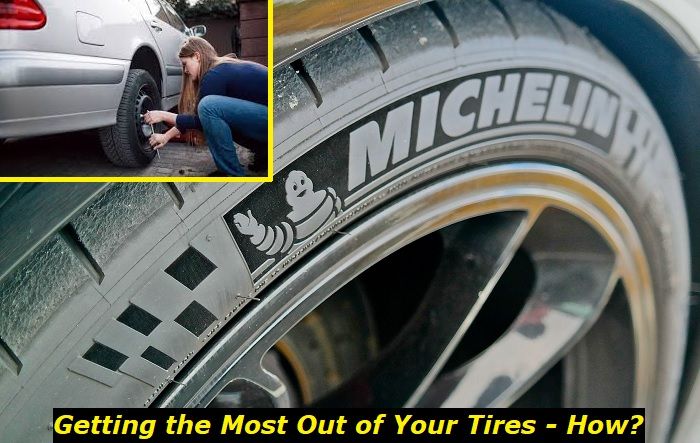The modern car is equipped with sophisticated systems and parts to ensure you have an easy time driving and using the car. When the tire pressure is low, a system alerts you. The same case occurs when the braking or fuel system has an issue. You may have come with a not-so-common warning message on your dashboard: "Power reduced to lower engine temperature".
Power reduced to lower engine temperature message highlights
- Common reasons:engine actually overheating, fan isn't working, low coolant level
- How to fix:stop the vehicle, let it cool down, check the coolant level, check the fan
- Possible consequences:engine may quickly die
- Priority level:High
- Can you drive?Not recommended
- DIY repair:Possible
- Repair price range:$0-$400

After scrolling through the online forums where car owners share their vehicle experiences, it will show that this is a predominantly Ford issue. Many people complaining of this issue own all manner of Ford models starting from around 2015 up to 2022. While some Ford truck owners have encountered this problem while towing, several reports from drivers of smaller cars who weren't hauling suggest it's not a towing problem.
"Power reduced to lower engine temperature"
When this message appears on the dash, the engine performance will automatically drop and only give you, say, 50 miles per hour. According to most Ford drivers, the warning message appears intermittently, and one cannot describe the exact conditions or circumstances in which it appears.
When the engine output drops, the vehicle will remain so for a while before switching back to normal, and you can reach 70 mph and more. Even though letting the engine cool down has been seen to solve this issue temporarily, it is best to establish the root cause. This will help you solve the problem once and for all and also help you avoid a dangerously huge mechanical bill in the future.
When the "Power reduced to lower engine temperature appears", it's easy and obvious to assume it is an engine problem. However, in almost all cases where this message appears, there is no check engine light, nor is the engine temperature gauge above normal. The first thing most drivers note is that the coolant temperature is normal, yet the vehicle is saying otherwise, and the engine performance is reduced.
What are the likely causes of "Power reduced to lower engine temp"
There doesn't seem to be a definite reason why this warning message pops up on your dashboard. However, after considering various driver experiences and mechanic opinions, we have come up with several possible causes of this issue.
1) Low-quality fuel
Some drivers reported seeing this warning after changing the type of fuel they usually use on their vehicles. In one case, the owner switched from 91 to 87 octane 'performance'. When the fuel-air ratio mixture is compromised, the engine will generate excessive heat, likely throwing a code.
If your vehicle's engine is designed to use 91 0r 93 octane and you switch to 87 octane, you run the risk of engine overheating. The 87 octane gas is prone to pre-detonation, while 91 and higher octane gas is more resistant. This will make the engine overheat, especially when you are towing a trailer. Another thing to note is that if your car engine is not designed to use 87 octane, for example, the ECU won't know when to change to or from the Tow/Haul mode. This will ultimately cause the engine to overwork, thereby overheating.
Some drivers have managed to resolve the "power reduced to lower engine temperature" by simply switching the octane fuel type they use in the vehicle. In many cases, the issue was almost certainly solved by switching back to the manufacturer-recommended fuel type.
2) A bad cylinder head temperature (CHT) sensor
A CHT sensor is a primary input component in a vehicle's PCM network aimed to monitor and control the torque converter clutch mechanism. When the CHT sensor goes bad, it will cause the PCM to register an overheating problem, which then causes the engine performance to drop.
There are times when the CHT sensor has been seen to become loose, making the PCM send the "power reduced to lower engine temperature". The sensor is found on the top end of the head, and it is easy to check whether it's loose or not. Replacing the sensor is quite cheap and only requires a little expertise to replace it.
3) Coolant leaking
The ever-flowing coolant in the cooling system absorbs the heat generated by the engine's moving parts. If the coolant is leaking, its level in the cooling system will drop, making it harder for the system to absorb the heat made by the engine. When the leakage is gradual, the "Power reduced to lower engine temperature" warning message might appear before the temperature gauge records the error.
Several people have resolved the reduced power issue by topping up the coolant in the reservoir. Several people have also noted that debris in the radiator causes problems in the cooling system that cause the reduced power issue. If you find debris or some blockage in the radiator, it will help you solve our said problem when you remove such debris.
4) Faulty exhaust heat exchanger bypass valve
The exhaust heat exchange is mounted on the exhaust pipe. Some F150 owners have resolved the "power reduced to lower engine temperature" problem by working on the exhaust exchange. This problem has been associated with a malfunction on the part of the exhaust exchanger, which then triggers a coolant temperature warning.
When you use an OBD scanner to run the codes for this problem, you will likely read P237D, which stands for exhaust heat exchanger bypass valve "A" control circuit low. The other code is P2C22, which stands for exhaust valve "A" position sensor circuit. The underlying possible cause of this problem is that the valve is stuck closed or open, which causes the exchanger's temperature to be too high.
When the exchanger malfunctions, the coolant is likely to get exceedingly hot locally in the exchanger. The problem would then arise when the ECM commands the exchanger to heat the coolant. Since the 'IN' and 'OUT' sensors of the exchanger will be reading the same temperature, a code is recorded, which will likely lead to the "power reduced to lower engine temperature".
5) False warning
Sometimes, the warning lights or messages on the dashboard are wrong. This means the warning is a false alarm, and you will need to remove such a warning message to stop seeing it. This should, however, not be mistaken to mean that every time your OBD scanner fails to read a code, the warning message is erroneous.
Read live engine diagnostics to get the most realistic results, especially given that the "power reduced to lower engine temperature" issue is intermittent. At such a time, you will tell whether the temperature sensors are reading incorrect high temperatures and setting off the reduced power mode.
What to do when "power reduced to lower engine temperature" appears?
- When the above warning message appears on the dash, the first instinct might be to pull over and call a towing company. However, that might not be necessary. As it has been reported by many owners who have experienced this problem and also mechanics, the message will go away after the vehicle's internal system temporarily resolves the issues.
- You could be traveling at 70 mph or towing a trailer when this message pops up. The engine performance will be reduced to 50 mph. Some drivers have reported parking by the side of the road for about 10 minutes before resuming their journey. You can usually drive for over an hour before the problem recurs.
- The cost of solving this issue will depend on what caused it in the first place. Where you have tuned the performance of your engine with lower octane fuel, all you have to do is switch to a higher or recommended gas grade. The CHT sensor will set you back around $20.
- The most important fact to know about the message you are reading on the dash is that it appears to prevent any damage to the engine due to continued performance at optimal capacity. When this message appears, therefore, it is imperative that you visit a qualified mechanic to have the problem sorted for good.
Conclusion
There are several reasons why the warning message stated above can pop up on your car's dash. The engine will choke to prevent any damage to the vehicle. However, as seen above, this message does not cripple the engine to limp mode. The reduced engine performance allows you to reach your destination. A better way to temporarily solve this issue is to let the vehicle cool down for ten or so minutes before driving off again.
About the authors
The CarAraC research team is composed of seasoned auto mechanics and automotive industry professionals, including individuals with advanced degrees and certifications in their field. Our team members boast prestigious credentials, reflecting their extensive knowledge and skills. These qualifications include: IMI: Institute of the Motor Industry, ASE-Certified Master Automobile Technicians; Coventry University, Graduate of MA in Automotive Journalism; Politecnico di Torino, Italy, MS Automotive Engineering; Ss. Cyril and Methodius University in Skopje, Mechanical University in Skopje; TOC Automotive College; DHA Suffa University, Department of Mechanical Engineering






Add comment